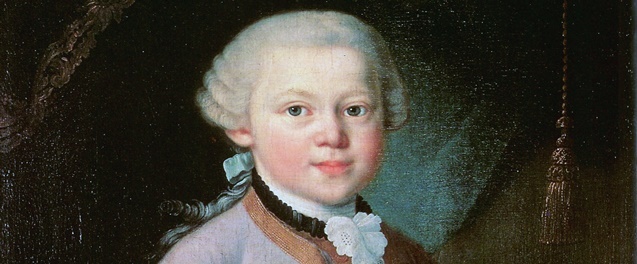In Vienna’s graveyard, next to the funerary monuments of Schubert and Beethoven, there is also a Memorial dedicated to one of the most distinguished composers of classical music: Wolfgang Amadeus Mozart. The visitors keep coming regularly and in large numbers to pay their respect to the music genius, but they do not realize they are victims of a deception: nobody knows precisely where Mozart was actually buried , not even his next of kin.
Mozart was interred with so many others in a common grave with the result that q few days later his corpse ceased to be identifiable with some degree of certainty. His wife Constanze did everything to throw some light onto the enigma that enveloped the composer’s death, but finding herself hampered at every step, she eventually left both Vienna and Austria. When in later life she married Baron Georg Nikolaus von Nissen, she again set off on her fact finding quest and came to the conclusion that Mozart had been murdered.
Indeed, for an unusual long time the Italian composer Antonio Salieri (1750-1825) had been suspected of poisoning Mozart. But although Salieri in more than one occasion acted against the interest of our composer, he surely never killed him.
DISAGREEMENT ON THE CAUSE OF HIS DEATH
The biographers and scholars of Mozart cannot concur on the absolute cause of his death which they list as Tuberculosis, or encephalitis, alcoholism or even syphilis. Thirty seven years after Mozart died, Constanze disclosed what the Baron von Nissen had discovered about her first husband’s death and had recorded in a book , which the Baron published , as very limited edition in 1828 just shortly before his own death. According to his theory the mandate behind the plot to murder Mozart were two powerful Masonic lodges that enlisted very important names, including those of Kings.
MOZART THE PRODIGY CHILD
Mozart was born on 27th January 1756 in Salzsburg, Austria. He was only four years old when he played some very difficult solo piano pieces. His father, Leopold Mozart, was a vice master of the Chapel of the Archbishop of Salzburg and through his occupation he was able to be introduced into the circles of Church high prelates , Court aristocrats and wealthy merchants who paid to hear and see Leopold Mozart’s children play.
And so at the age of only five Wolfgang was taken away from his childhood games and together with his two sisters put on exhausting concert tours all around Europe.
At the age of twenty, Mozart was employed by the Archbishop [1] of Salzburg as a lowly paid court musician. He expected that the Archbishop should show him admiration for his talent and above all respect him and treat him differently from his servants. But the prelate, exasperated by but what he considered arrogance on the part of the young man, took no notice and on one occasion even publicly humiliated him. When Mozart later offered a letter of resignation, the Archbishop is reported to have replied: “Let’s do away with this dissolute and mad lad. As he does not want to serve me…show him the door!”.
At last Mozart was free and as a freelance musician he begun wondering from city to city , kingdom to kingdom, in search of a well remunerated and respected position as Court composer.
MOZART THE FREEMASON
Mozart was initiated on 14th December 1784 in Vienna at the lodge “Zur Wohlthatigkeit” by Otto Von Gemminngen, Grand Master and also Chamberlain to the Emperor of Austria Joseph II. The “Zur Wohlthatigkeit” worked closely with the lodge “Zur Wahren Eintracht” or “True Harmony” which had about 200 members, mostly aristocrats, with a third of those also being members of the secret sect of the Bavarian Illuminati.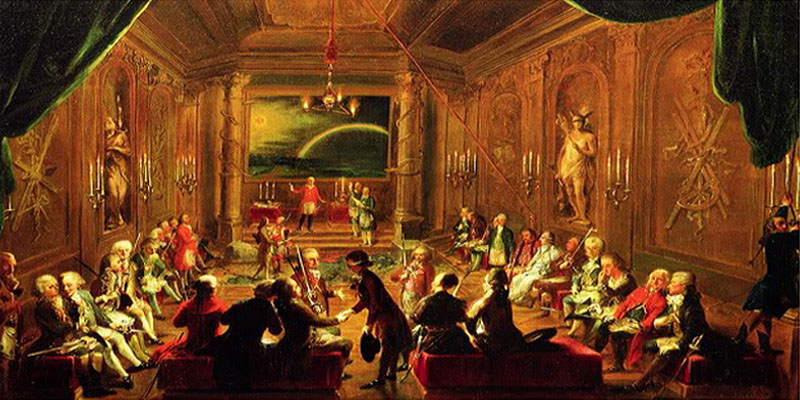
Mozart could not help being affected by those minds but later he came to realize that the Bavarian Illuminati had a concealed agenda that extended beyond the wishes of transforming the social order based on the ideals of the Enlightenment. He also suspected that those Illuminati were behind the many problems he was constantly experiencing both in life and professionally.
Disenchanted, Mozart made plans to set up his own Lodge. He called it “Die Grotte” and based it on different principles than those of the Illuminati; it even had its own constitution. But in the end nothing came of it.
In the year 1789 France took arms against the old regime and social order and staged one of the bloodiest and longest known insurgences in history; its ideals of “freedom, fraternity and equality” had been borrowed from Freemasonry which ,although it never denied helping the subversion, took steps to distance itself from the years of terror that ensued.
THE MASONIC SYMBOLS IN “THE MAGIC FLUTE”
Mozart’s libretto had been adapted by his friend, the theatre director and Freemason Emanuel Schikameder (1751-1812), and been written in collaboration with Karl Ludwig Gieseke, an expert of symbolism and a very interesting character indeed.[2] The symbolism employed has been interpreted in many different ways but the following is the meaning I have chosen for you.
“The magic flute had been built thousands of years back by the father (or Fatherland, i.e. the German nation) of Tamino (alias Mozart) using only genuine German oak. What Tamino , with his (German) music wishes to accomplish is to move the hearts of the Illuminati in order to save the prisoner Pamina (alias Marie Antoinette Queen of France) whom, for the sake and love of her mother the Queen of the Night (alias Maria Therese of Austria) has even accepted to be incarcereted (by the French Jacobins).”
Mozart must have realized that if his message had been misunderstood or not embraced, he was destined to pay with his life!
THE MISTERIOUS COMMISSION
In September 1791 Constanze and Mozart travelled to Prague where he had been commissioned to compose an opera for the crowning celebrations of the Emperor Leopold II (1747-1792). He wrote the complete scoring in merely three weeks and also directed the staging of the Opera himself. The title of his composition was “La clemenza di Tito” and he based it on a story by the Italian poet Pietro Metastasio (1698-1782).
However, just before his departure for Prague, Mozart had received a bizarre visit from a strange messenger who presented him a letter of commission to compose a “Mass in Requiem”. Mozart accepted and a few days later the messenger returned with a substantial sum of money and the promise to pay an even greater amount when Mozart had fulfilled the contract.
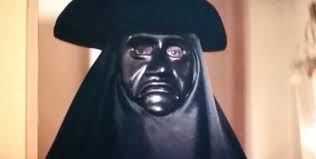 On the day that Mozart and his wife Constanze mounted their carriage to set off from Vienna to Prague, the same dark messenger approached him and asked: “How is the Requiem progressing?” Mozart answered that he would have it ready on his return but that event prompted the countdown to his last one hundred days of life! The historian Georg Fredric Daumer (1800-1875) was of the opinion that Mozart had received his first dose of poisoning on the day of his arrival in Prague, causing him: “swelling of the hands and feet, followed by bouts of sudden vomiting”.
On the day that Mozart and his wife Constanze mounted their carriage to set off from Vienna to Prague, the same dark messenger approached him and asked: “How is the Requiem progressing?” Mozart answered that he would have it ready on his return but that event prompted the countdown to his last one hundred days of life! The historian Georg Fredric Daumer (1800-1875) was of the opinion that Mozart had received his first dose of poisoning on the day of his arrival in Prague, causing him: “swelling of the hands and feet, followed by bouts of sudden vomiting”.
Mozart’s realization that he was dying became clearer when he returned to Vienna. One day, after a long walk in the Prater with his wife Constanze, he sat on a bench and told her that he feared he was being poisoned.
A DEATH PRESENTIMENT
Life was at last being good for Mozart. In Prague his Operas were highly successful, in Vienna he had been rewarded with the office of Kapellmeister of Saint Stephen Cathedral and commissions for more compositions were were rolling in. It was a time of plenty for Wolfgang. Nevertheless, he wrote in a letter:
“I have to go now that I could live happy! I have to abandon my art when I no longer am a slave of fashion, when I could compose freely all that my heart inspires me. I must abandon my family, my poor children, right when I could provide a better life for them than ever before!”.
In November 1791 Mozart composed the “Little Masonic Cantata K 623” which was received with much enthusiasm and gave him the strength to go on composing the Requiem. But the death presentiment kept tormenting him day and night and Gieseke – who had collaborated to “The Magic Flute” with his knowledge of Masonic symbolism – had in the meantime abandoned Vienna and fled to England. A few days before he passed away, Mozart wrote: “I never imagined this Requiem was meant to be for me “
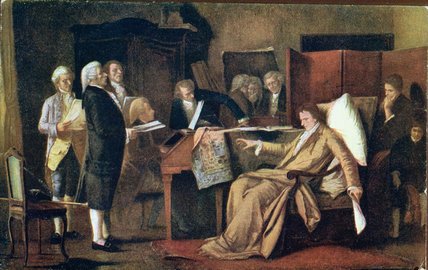 The day before his death, Mozart had rounded up some of his friends at home. Whilst speaking to them about the Mass in Requiem he suddenly experienced ghastly strong colic attacks that caused him to heave and cry and his hands and feet swell with body fluid. He died the following day, 9th of December 1791, at the young age of thirty five.
The day before his death, Mozart had rounded up some of his friends at home. Whilst speaking to them about the Mass in Requiem he suddenly experienced ghastly strong colic attacks that caused him to heave and cry and his hands and feet swell with body fluid. He died the following day, 9th of December 1791, at the young age of thirty five.
THE TRAGEDY OF HIS BURIAL
A few hours after the end of Mozart’s life, the mysterious emissary of the Mass in Requiem knocked at the door demanding Mozart’s scores. Constanze obliged.
Baron Van Swieten – one of the richest Dutch aristocrats residing in Vienna and a Freemason from Mozart’s Lodge – offered to take care of everything. He was a long standing friend of the family and Constanze was undoubtedly thankful that he had stepped in. But Van Swieten had only come to take charge of the second part of the tragedy. He sent Constanze away from Vienna so that the creditors would not come to knock at the composer’s door, went through Mozart’s papers to ensure that no compromising masonic documents were left to be found, and arranged a hasty poor-man funeral and burial. Nevertheless, Mozart’s friends and family did not fail to notice and be surprised by the unusual and extraordinarily quick decomposition of Mozart’s body within a few hours. It defied the extremely cold conditions of the day which had been characterized by copious snow and rain falling from the sky. The coffin was taken for a blessing to the Cathedral of Saint Stephan and thereafter to the cemetery. The extreme weather, however, forced the funeral procession participants to seek refuge in the graveyard guardian’s room and prevented them from witnessing the actual burial. This was noted to have occurred the following day, away from prying eyes and in a grave already containing fifteen or so other paupers’ bodies.
Ten year later ,in 1801, the grave was cleaned to make room for new burials, but of course the bones were found scattered here and there and made any identification impossible. The skull recovered from that grave by an undertaker and kept in the Salzburg’s Mozart Museum, cannot therefore be proven to be that of the composer. Even the tombstone and the monument erected by the city of Vienna to celebrate the artist’s life have been placed in random locations that are not connected with Mozart.
THE OCCULT SYMBOLISM
When Constanze, a few days from her husband’s death, returned home and tried to identify his grave, she found no clues. The head grave-digger whom she probed told her that he knew nothing; he had only recently succeeded his predecessor who had suddenly died.
It was common belief, in some magic circles , that the “worshiped” grave gives the soul of the dead person some magic powers that can be used in the afterlife. Not even the bones should be kept in memory. Is that why Mozart was buried in a common grave and the gravedigger ordered not to record its exact site ?
The Mozart Museum of Salzburg has a letter by Ludwig Van Beethoven[3] in which he 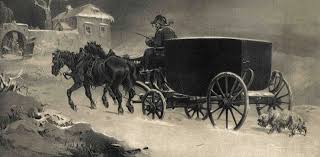 reports that at Mozart’s funeral only one stray dog followed the hearse. Notably in “Faust” , a tragic play by the Freemason and Illuminatus Goethe, the devil appears as a stray dog and draws magic circles…
reports that at Mozart’s funeral only one stray dog followed the hearse. Notably in “Faust” , a tragic play by the Freemason and Illuminatus Goethe, the devil appears as a stray dog and draws magic circles…
The strange causes and circumstances of Mozart’s premature demise remain uncertain to these days and are responsible for feeding the aura of mystery that surrounds this musical genius.
By Aldo Reno
The author forbids any reproduction or publication of this article, in full or in part, without his explicit authorization.
[1] Count Hieronymus Joseph Franz de Paula Graf Colloredo von Wallsee und Melz (31 May 1732 – 20 May 1812)
[2] Karl Ludwig Giesecke (1761 – 1833), later known as Sir Charles Lewis Gieseke
[3] Appropriately called “the poor man’s funeral” (Le convoi du pauvre)
- His Majesty’s Servant , David Garrick Esq – Freemason ? - June 7, 2024
- Influencia de la Masonería en Chile - April 29, 2024
- Pomegranate in Freemasonry – its significance - March 11, 2024

